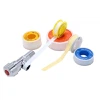The core difference between polytetrafluoroethylene (PTFE) and fluoroelastomer lies in the material category and application characteristics:
1. Differences in material category
Polytetrafluoroethylene is a plastic and is a crystalline polymer of tetrafluoroethylene monomer. The chemical formula is (C2F4)n, which has rigidity and low friction coefficient.
Fluoroelastomer is a rubber, usually composed of copolymerization of tetrafluoroethylene and other monomers (such as hexafluoropropylene), showing amorphous structure, mainly elastic deformation.
2. Comparison of physical characteristics
Elasticity: The elastic deformation of fluoroelastic rubber can reach more than 1000%, while polytetrafluoroethylene is less elastic (<100%). Friction coefficient: Polytetrafluoroethylene has extremely low friction coefficient (0.05-0.10), suitable for lubricating and anti-stick coatings; fluoroelastomer is mainly used for sealing.
3. Temperature resistance and corrosion resistance
Temperature range:
·Polytetraethene:-180°C ~ +260°C
·Fluoroelastomer:-50°C~+250°C (some products can reach -196°C~+260°C)
Corrosion resistance: Both are resistant to strong acids, strong alkalis and organic solvents, but polytetrafluoroethylene is more resistant to chemical corrosion due to its pure material properties.
4. Application fields PTFE: used in non-stick coatings, insulating materials, pipe linings, etc., such as Teflon coatings.
Fluoroelastomer: mainly used for high-demand seals, such as 0-rings and sealing gaskets.
Summary: Polytetrafluoroethylene is known for its rigidity, corrosion resistance and lubricity, while fluoroelastomer has its core advantages in elasticity and sealing. The two are used complementary in chemical industry, aerospace and other fields.










